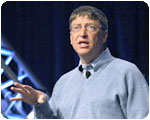|
||||||

|
|
|||||
|
Gates' Visual Studio 2005 Vision
VSLive! San Francisco, March 24, 2004
Bill Gates launched the combined VSLive!, Microsoft Mobile DevCon, and AVIOS SpeechTEK conferences on Wednesday, March 24, 2004 with his keynote speech to a standing-room-only crowd at San Francisco's Moscone Center West. Gates adopted the "Seamless Computing" theme for his three-pronged, developer-oriented address, which emphasized VS.NET's integrated toolset for an upgraded Windows Mobile 2003 release and Microsoft's newly announced Speech Server 2004 (see Resources). Gates' opening remarks also focused on device proliferation, code quality and security, and standards-based Web services for connectivity. The first of the three demos showed new productivity features for VB developers in the Visual Studio .NET 2005 Community Technical Preview (CTP). The CTP is the second preview of the next version of VS.NET, formerly known as "Whidbey," scheduled for release in the first half of 2005. A simple insurance claim app demonstrated the CTP's upgraded DataConnector (DataContainer in the first TP) tool that can enable business objects, in addition to conventional DataSets, as data sources. The CTP automatically builds an XML schema for the business object; the DataContainer adds a GridView or data-bound textboxes for a detailed view with a single click. An edit-and-continue example drew the obligatory—but muted—applause. Other VB.NET code productivity enhancements include Generics, the ability to create a data connection with a single line of code, the VB.NET-only My object whose members provide access to local computer resources and properties of the current user's Windows account, and "code snippets" for performing common tasks. The final product will ship with more than 500 snippets, and you can expect snippets to become the primary code distribution method for .NET-oriented Web sites. New Exception Assistants suggest fixes for the offending code but are reminiscent of the ill-fated Office Assistant. Gates claims that new VS.NET 2005 features will reduce hand-written lines of code by 50 percent, but the question remains: "Compared to what?" One-Click Web deployment promises to automate distributing and updating completed .NET projects and their dependencies. Conference attendees and MSDN Universal subscribers will receive the CTP bits. Going Mobile Ori Amiga, group program manager of the developer division of Microsoft Visual Studio for Devices, demonstrated improved mobile code development productivity in the second demo. Two lines of VB.NET code enable built-in camera display, and one line implements a Web service connection to MapPoint Location Services (MLS), which Microsoft announced on March 22 (see "Introducing MapPoint Location Server"). MLS is a network operator-independent Web service for obtaining the location of a cellphone user that integrates with MapPoint Web Services to deliver location-dependent data, such as maps, restaurant guides, and other services. MSDN Universal and Professional subscribers can sign up for the MapPoint Web Services special license offer at the MSDN Subscriber downloads site (see Resources). Gates also announced a new Mobile2Market incentive for certification and marketing mobile applications, and a mobile application contest with four $25,000 first prizes (see Resources). Speech Synthesis Richard Irving, a Microsoft Speech Server (MSS) 2004 program manager, demonstrated writing a speech-enabled ASP.NET app related to the first VB.NET demo. He defined a dialog with the DataTable Navigator, a member of a collection of special-purpose VS.NET tools that the Speech Application SDK adds to the Toolkit. He then used the Grammar Editor to define allowable user responses to synthesized or pre-recorded questions. After testing the Speech Server simulation app running under ASP.NET, it should be easy to deploy the project to a production server connected to live phone lines. Irving gave a persuasive—but prebuilt—demo of the final project. Gates went on to describe a live Speech Server application for parents of students in a New York City school district. The app lets families without PCs access children's academic and related records, which previously required an Internet connection, and avoids adding staff to handle the calls. Developers who have worked with the Professional Developers Conference 2003's Whidbey Technical Preview didn't gain appreciable information about what's new in the CTP, and the Windows Mobile 2003 Second Edition demo didn't plough much new ground. Speech Server 2004, however, promises a major improvement to the development process for speech-enabled applications. And, as a final aside, I heard Bill Gates mention Longhorn only once.
About the Author |

 Watch the video of the keynote!
Watch the video of the keynote!